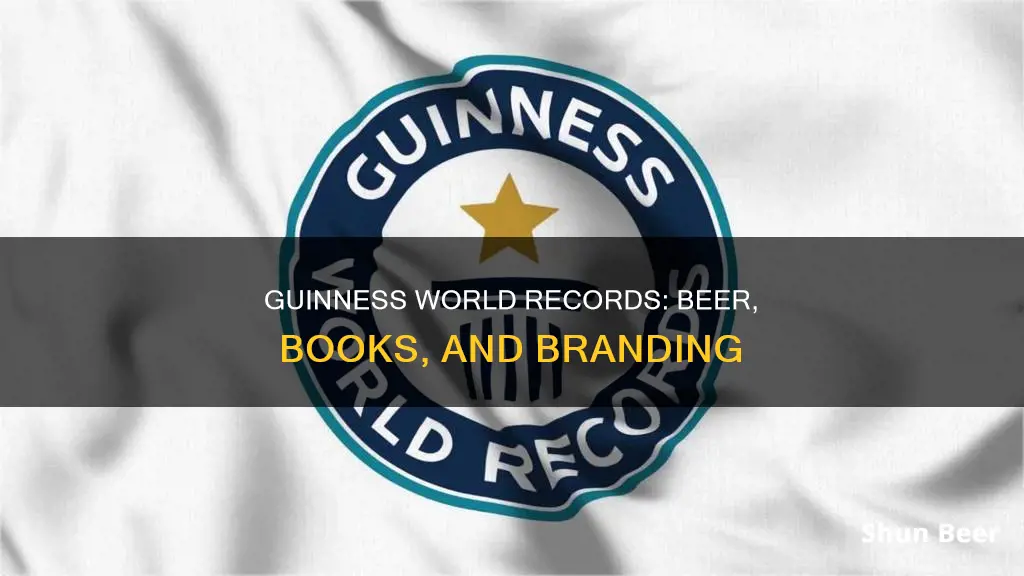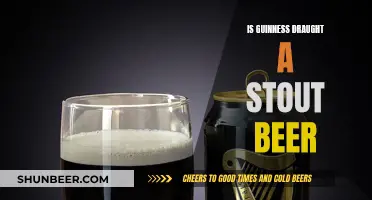
The Guinness Book of World Records and Guinness stout are indeed related. The book was started by the managing director of Guinness Breweries, Sir Hugh Beaver, in 1951. The idea for the book came about when Beaver was involved in a discussion about the fastest game bird in Europe, and he realised there was no single official record of the answer. With the help of journalists and brothers Norris and Ross McWhirter, Beaver amassed records into a book, which was published in 1955. The book was initially created as a promotional item for the Guinness brand, but it soon became clear that it had tapped into a public curiosity.
| Characteristics | Values |
|---|---|
| Guinness World Records founded by | Sir Hugh Beaver, managing director of Guinness Breweries |
| Year founded | 1951 |
| Reason for founding Guinness World Records | To settle pub arguments about the biggest, fastest, etc. |
| First edition publication year | 1955 |
| First edition number of pages | 198 |
| First edition number of copies | 50,000 |
| Current owner | Jim Pattison Group |
What You'll Learn

Guinness World Records was founded by the Guinness brewery
Guinness World Records was founded by Sir Hugh Beaver, the managing director of Guinness Breweries, in 1951. The idea for the book of records came about during a shooting party in County Wexford, Ireland, when Beaver became involved in a debate about the fastest game bird in Europe. After failing to find the answer in reference books, Beaver realised there was no single official record of the fastest game bird or, indeed, of much else.
With the help of brothers Norris and Ross McWhirter, who were journalists, Beaver amassed records for a book. The book was published in the summer of 1955 and 50,000 copies were distributed for free to pubs across Britain and Ireland as a promotional item for the Guinness brand. The book was immensely popular and a further 50,000 copies were sold to the public. It topped the British bestseller list by Christmas of 1955 and the following year it was launched internationally.
The Guinness Book of Records became so popular that it now holds its own world record as the best-selling copyrighted book of all time. It has sold more than 100 million copies in 100 different countries and is printed in 37 different languages. The Guinness beer company and Guinness World Records are no longer officially linked, having been put under separate ownership in 2001.
Guinness: A Dark Porter Beer With a Rich History
You may want to see also

The book was created to settle pub arguments
The Guinness Book of World Records was created to settle pub arguments. The story goes that in November 1951, Sir Hugh Beaver, then the managing director of Guinness Brewery, went on a shooting party in County Wexford, Ireland. After missing a shot at a golden plover, he became involved in a dispute with his hosts over which was the fastest game bird in Europe. That evening, Beaver and his companions tried to find the answer in reference books but to no avail.
Beaver realised that there was no single book in the world that could settle arguments about records. He decided to create one, enlisting the help of journalists and twins Norris and Ross McWhirter to amass records. The book was initially intended as a promotional item to be distributed for free in pubs across Britain and Ireland. A thousand copies were printed and given away. However, the book proved immensely popular, and Beaver soon realised he had tapped into a public curiosity.
The Guinness Book of Records was first published in August 1955 and became a bestseller in the UK by Christmas of that year. It sold 50,000 copies and was soon launched internationally, with an American edition debuting in 1956. The book has since been translated into multiple languages and has sold millions of copies worldwide.
The book was so successful that it spawned a TV series, "The Record Breakers", which aired from 1972 to 2001. The Guinness Book of World Records is now a global brand, with offices in several countries and continues to be the primary international source for cataloguing and verification of world records.
Guinness Beer: Healthy or Harmful?
You may want to see also

The book was initially a promotional item for the Guinness brand
The Guinness Book of World Records, or Guinness World Records, was initially a promotional item for the Guinness brand. The idea for the book came about in 1951 during a shooting party in County Wexford, Ireland, attended by Sir Hugh Beaver, then the managing director of Guinness Breweries. Beaver missed a shot at a game bird and, during a discussion about the fastest game bird in Europe, he realised there was no official record of the answer. He also presumed that many other arguments and debates, perhaps over a pint of Guinness, could be settled with a book of world records.
Beaver recruited journalists and brothers Norris and Ross McWhirter to help him amass records and publish them in a book. Norris and Ross McWhirter sent letters to experts from a range of fields, from astrophysicists to gerontologists, asking for help in verifying the records. The book was created in "thirteen and a half 90-hour weeks", including weekends and bank holidays.
The first edition of the Guinness Book of Records was published in the summer of 1955. A thousand copies were distributed for free to pubs across Britain and Ireland as a promotional item for the Guinness brand. The book proved immensely popular with customers, and a second edition of 50,000 copies was soon published and sold to the public. By Christmas of 1955, it had topped the British bestseller list, and the following year it was introduced internationally, selling 70,000 copies in the US.
The book continued to grow in popularity, with new editions published annually and eventually sold in over 100 countries and 40 languages. By 1966, the book had sold over 1.5 million copies and topped bestseller lists in several European countries. The Guinness Book of Records became a household name and is now the best-selling copyrighted book of all time, with over 100 million copies sold.
While the Guinness beer company and Guinness World Records are no longer officially linked, the book was originally conceived as a promotional item for the Guinness brand and played a key role in its marketing strategy.
Guinness Beer: Flavors and Varieties You Need to Try
You may want to see also

The Guinness logo was put on each copy of the book
The first edition of the book was published in 1955, and was initially distributed as a promotional item to bars and pubs across Ireland and the UK that stocked and sold Guinness beer. However, the book became so popular that Sir Hugh Beaver, the creator of the book and then-managing director of Guinness Brewery, decided to sell it to the public.
Beaver had the idea for the book after a shooting party in County Wexford, Ireland, in November 1951, where he and his hosts argued about the fastest game bird in Europe. They could not find the answer in any reference book, and Beaver realised that there was no single book that settled arguments about records.
Beaver recruited Norris and Ross McWhirter, two journalist brothers, to help him amass records and publish them in a book. The book was written in thirteen and a half 90-hour weeks, including weekends and bank holidays. The first edition was 198 pages long and 50,000 copies were made and sold to the public. It topped the British bestseller list by Christmas of 1955 and sold 70,000 copies in the US the following year.
The Guinness beer company and Guinness World Records are no longer officially linked, having been put under separate ownership in 2001.
Guinness Beers: Exploring the Diverse Range of Stouts
You may want to see also

The Guinness Book of Records became a TV series
The Guinness Book of Records, now known as Guinness World Records, was indeed related to the Guinness beer company when it was first published. The idea for the book came about during a hunting trip in 1951, when Sir Hugh Beaver, then the managing director of Guinness Breweries, missed a shot at a game bird and wondered which was the fastest game bird in Europe. Unable to find the answer in any reference book, Beaver realised that there was a gap in the market for a book that could settle such pub debates.
With the help of Norris and Ross McWhirter, a pair of journalist brothers, Beaver amassed records into a book that was published in the summer of 1955. Initially, 50,000 copies of the book, which featured a water-repellent cover, were distributed to pubs as promotional items for the Guinness brewery. However, the book soon proved to be immensely popular, and Beaver quickly had to secure office space for the McWhirter brothers to work on a new edition. The first edition of the book sold out by Christmas that year, and it has since become the best-selling copyrighted book of all time, with over 150 million copies sold in 100 countries and 40 languages.
Guinness Beer: Healthy Brew or Just a Buzz?
You may want to see also
Frequently asked questions
Yes, Guinness World Records was started by the managing director of Guinness Breweries, Sir Hugh Beaver, in 1951.
Beaver was on a hunting trip and missed a shot at a game bird. This led to a discussion about the fastest game bird in Europe, which he was unable to settle. He realised there was no single source that officially settled such debates, and so he decided to create one.
Beaver recruited two journalists and brothers, Norris and Ross McWhirter, to help him compile a book of records. They sent letters to various experts, from astrophysicists to gerontologists, to verify the records. The first edition of the book was published in 1955.
Yes, the book was initially created as a promotional item for the Guinness brand and 1,000 copies were distributed to pubs across Britain and Ireland. However, it became immensely popular with customers, and 50,000 copies were soon sold to the public. It went on to top the British bestseller list by Christmas 1955 and has since sold more than 100 million copies worldwide.
No, the Guinness beer company and Guinness World Records are no longer officially linked, having been put under the ownership of different entities in 2001.







